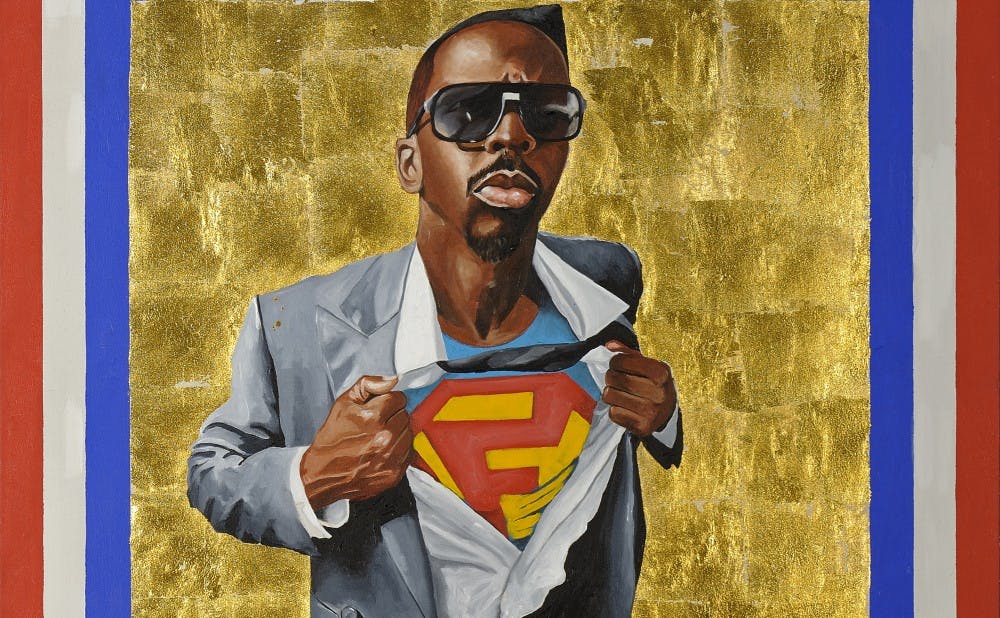Right in the entrance of the Nasher's "Reality of My Surroundings" exhibition is an overwhelming exposure to sparkles and color. A viewer's eyes are immediately and inevitably drawn to artist Ebony G. Patterson's sparkling canvas, "...shortly after 8- beyond the bladez," on the left and Fahamu Pecou's "Nunna My Heroes After Barkley Hendricks' 'Icon for My Man Superman,'" depicting a confident black man wearing Superman's iconic suit on the right.
The "Reality of My Surroundings" exhibition primarily consists of works by artists of African descent, focusing on cultural, social and gender related issues. Beyond the initial glamor that is presented in the first room of the exhibition, from the dazzling material reflected from Patterson's work to the sophisticated looking man in a suit in Jeff Sonhouse's "Decompositioning," the severity of the images manifest clearly upon closer look. Such a characteristic of the art pieces in the exhibit forces, quite fittingly, a new perspective on the reality of one's surroundings. This perspective is particularly significant, poignant, and relevant in modern culture and society.
"This is a critical moment where we have to acknowledge and deal with the unjust racial violence against people of color in this country and world-wide," said Trevor Schoonmaker, chief curator and Patsy R. and Raymond D. Nasher Curator of Contemporary Art. "Social media and the Black Lives Matter movement have really helped bring awareness to this issue over the past year."
However, the exhibit does not solely touch on the racial implications and tensions that are portrayed through works by artists of African descent. The breadth of the art pieces extends broadly into many facets of human culture, including works from artists all over the world and touching on themes such as sexual violation, the scars of internment camps, and brutality of war. Schoonmaker described the exhibition as a form of "global conversation" in which the art collection can provoke thought and in that way, promote discussion and change.
"Artists are always the first to see and interpret what is going on in the world around us, good and bad, commenting on aspects of our contemporary or past environment by finding their own unique visual expression," said Sarah Schroth, Mary D.B.T. and James H. Semans Director of the Nasher.
Schroth elaborated on the various mediums of expression, including direct personal references (Crosby, Frazier, McIver), imagery referring to a specific event or period in time (Boltanski, Thomas), and cultural issues and symbols (Anderson, Escobar, Ward, Marshall). Art pieces also employ ironic humor (Johnson, Hirschhorn), but also expressions of great beauty (Hendricks, Wiley, Smith).
Walking through the exhibit itself creates a explorative and developmental journey. The particular order and categorization of the pieces in each room work to stimulate questions and new ways of thought about each piece as an individual work and as a collective grouping.
"Any non-linear exhibition can be hung a number of ways, but a curator strives to create meaningful conversations between specific works that help render insightful and/or unexpected readings of those works, while still always being visually cohesive and harmonious," Schoonmaker said. "Placing Steve McQueen’s 'Girls, Tricky' video at the beginning is purposeful, positioning it as the heartbeat of the exhibition. It is one of our new acquisitions."
Perhaps the most stunning of the art pieces, "...shortly after 8- beyond the bladez" utilizes a mix of mediums including glitter, fabric, and rhinestones to depict a scenery of verdant flora and dreamlike background. However, beneath the near ostentatious design is a black man lying down, spread eagle on a red path, a stark contrast against the surrounding green. The red conjures up images of blood and violence while the man seems powerless and victimized by it, evoking one of the exhibit's core themes of "bringing visibility to the often marginalized."
Similarly, Fahamu Pecou's "Nunna My Heroes" probes beyond the surface image of a brave, heroic black Superman. Based on Barkley Hendricks' 1969 painting Icon for My Man Superman, "Nunna My Heroes" depicts the artist Pecou himself as a Superman. His body language and position show him revealing his Superman attire underneath his suit, but the visible portions of his face portray a distinct frown, as though slightly confused or irritated. The top quote "Aint nuthin but a sandwich" seems to emphasize a meaninglessness behind the numerous layers that Pecou has on, from the Superman clothing to his own skin color. As though to drive the point through, in the caption there is political activist Bobby Seale's quote "Superman never saved any black people."
Further into the exhibit, the works begin to touch upon other themes and topics. In one section of the exhibit, a sculpture of several pairs of hands gripping barbed wire reflect the intensity and strife from internment camps during the Holocaust. This piece, "If the Leader Only Knew by Hank Willis Thomas," displays a carefully individual precision to detail, ranging from the different creases and sizes of hands to the attention to various cuffs that the person might be wearing around their wrists. However, there is also a broader, more general message that seems to memorialize the instant.
One of the most jarring paintings is displayed in the last room of the exhibit, showing a nude woman being held by the wrists by two soldiers with large, conspicuous black censor bars. The painting is an interpretation of a photo of a woman in a similar position during the Algerian civil war. The expressive brush strokes and few colors leave the identities of the three individuals lost, but focuses almost brutally on the violation and speculation of the woman's fate.
What is the reality of one's surroundings? "Reality of My Surroundings" points to an ambiguous answer found somewhere between looking at what is directly in front and seeing beyond the medium into an emotional level of acknowledgment.
Get The Chronicle straight to your inbox
Signup for our weekly newsletter. Cancel at any time.

